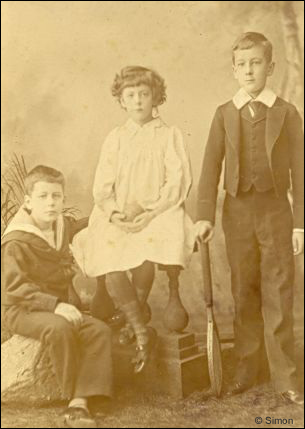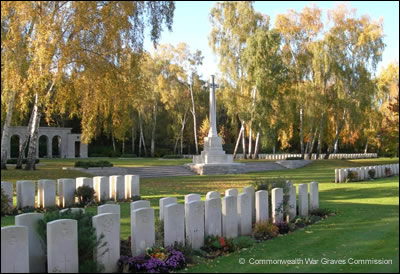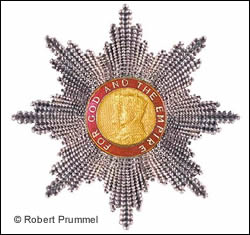My dad’s uncle, Hugh Benson, was born on 28th July 1882. His early childhood was spent living in a large house called ‘The Mount’ in Sparepenny Lane, Farningham, Kent, with his father William, mother Marion, older brother Alick (1879) and younger sister Marjorie (1884). It was an affluent family employing five servants. It seems that Hugh’s father left his mother and young family when Marjorie was born and Hugh was about 2 years old. His father emigrated to South Africa.

Although Marion didn’t consider herself to be as well off as before the separation, she was provided with an income sufficient to maintain a house in the Cromwell Road, Kensington, with three or four resident servants, and enough funds to send her two sons to St. Paul’s School.
Family legend had it that Hugh went out to fight in the 2nd Boer War (October 1899 to May 1902) and decided to stay in South Africa, possibly having met up with his father. We know that his mother sent him grey woollen socks to keep warm. It was also said that Hugh fought in WW1 and was in the army again for WW2 before being killed while fighting with the South African forces at Tobruk around 1941/1942.
I decided to look into the facts behind what I thought would be an interesting, yet brief, story. It turned into one of the most fascinating stories which I have come across on the numerous branches of my family tree which you can read further about here. I discovered that Hugh Benson did indeed fight with the South African forces in WW2, but he was not killed at Tobruk!
The first source of information I went to was the Commonwealth War Graves Commission (CWGC) website where I found a dedication to him at the Berlin 1939-45 War Cemetery a few miles outside Berlin.
It says :
In Memory of Corporal HUGH BENSON O.B.E.
1864, 1st Bn., Royal Durban Light Infantry, S.A. Forces who died age 62on 12 July 1944 Son of William C. Benson and Marion F. Benson; husband of Mary H. Benson, of Edinburgh. Remembered with honour. BERLIN 1939-1945 WAR CEMETERY
So, he was a corporal and had been awarded an O.B.E.!

Reproduced with the kind permission of the Commonwealth War Graves Commission
Intrigued, I then contacted the Commonwealth War Graves Commission itself and the only additional information they could give me was the actual burial plot reference and the fact that he had previously been buried at Neuburxdorf, Germany, and was reburied in Berlin on 5th June 1947. I discovered most of those who were buried at Neuburxdorf had died whilst being prisoners of war in the huge Stalag 4B camp at nearby Mühlberg, which held up to 16,000 POWs. Rather than dying at Tobruk it seemed likely that he had probably been taken prisoner and then moved behind enemy lines, dying two and a half years later.
It did seem strange that he was still a serving soldier at 62 years of age. He would have been 57 at the outbreak of WW2. Would someone nearly 60 years old have been encouraged to sign up?
In order to find out, I wrote to The Department of Defence in Pretoria, South Africa, hoping they could let me have access to his service record, which they did. It seems he lied about his age when signing up in 1940, by saying that he was born in 1895, rather than 1882. Trying to pass himself off as being 13 years younger than he was must have been difficult, especially as his hair was unsurprisingly described as ‘grey’.
His South African service records show that when he re-enlisted in 1940 it was as a private. The letter I received from Pretoria says there is “no record on his personnel file of an O.B.E. being awarded to Private Benson”. So where did ‘corporal’ and ‘O.B.E.’ on the CWGC memorial come from?
I subsequently tried in vain to find out what his O.B.E. may have been awarded for, but there are no lists in the public domain other than the birthday honours list published in The Times newspaper. By not knowing what year to look for and with the print being very small, it is like looking for a needle in a hay stack. O.B.E.s were first awarded in 1917, so we are talking about a possible 27 year search span! I must say that given Hugh’s ability to persuade the authorities that he was 13 years younger than he actually was, I believe that this award may also have been a figment of his overly active imagination and ability to story tell.
Surprise development
As far as I was concerned, this was all I was expecting to find and I was quite happy with that. Just by chance, I was invited to a hospitality evening to enjoy a 20:20 cricket match at The Oval, in London, a few years ago, and got talking to someone about the fact that I had a British relative who had seemingly emigrated to South Africa and who had died as a POW while serving for a South African regiment.
This chap put me in touch with a Royal Durban Light Infantry historian in South Africa and not only did he send me a copy of the photograph showing Hugh’s burial (shown below), he also sent a transcription of a fascinating article which appeared in the July 1967 issue of ‘Flash’, the regimental magazine.
The article reads as follows:-
“I am indebted to Eric Everitt, ex Sergeant, 2nd RDLI, for several interesting books, publications and newspaper cuttings, all dealing with the war years 1939/45. Amongst the papers he let me have was this photograph of a burial service being held in Stalag 4b, sometime during 1944. I was intensely interested in the photograph because of the fact that a German firing party was being used at the burial of an ‘enemy’. I eventually established the fact that the man who was being buried was Hugh (Pop) Benson, who served in the “I” section of the 1st RDLI. It would appear that Pop was quite a character and this certainly must have been so, for who other than a real character could have persuaded the authorities that he was under 45 when in fact he was already over 60.

“Hugh Benson, a Major, M.C. in the 1914-1918 war, was farming in the Underberg area at the outbreak of the Second World War. He immediately gave up his favourite sport and pastime, otter hunting with a pack of home grown dogs, and set out for Durban, where he promptly got himself tied up with the 1st RDLI. Many efforts were made to persuade this old sweat to accept rank of some kind but he fought off all onslaughts on his privateship. Eventually however, he agreed to become a lance-jack in the (I) Section.
Hugh, a fairly quiet man, never really had much to say for himself – certainly he rarely spoke of his First World War experiences. He was fantastically fit for his age, a real hog for hard work and fatigues. He was generous to a fault, kindly, and often took guard duties and unpleasant chores away from younger chaps in the Regiment. He was renowned as a marcher of routes and could walk most men off their collective feet.
It was Pop’s lot to be attached to the composite Battalion (Blake Group) which went into ‘the sack’ at Tobruk and from there he was drafted, together with so many other RDLI chaps, to Stalag 4B where eventually he died. How sad it is that so fine a man, so good a soldier as Hugh Benson, should have been buried so far from home, and yet how fitting that he, with ‘war and army’ in his very blood, should have been buried with military honours in the presence of both enemy and friend. Yes, indeed, Pop Benson was a soldier of whom we of the DLI can and must remember with pride”.
Tubby Goldman (Author).
Wow!

It is one thing finding out that my ancestor was given a military funeral by the enemy, but quite another to discover his previously unknown background and how much he was respected by his colleagues. I was already sceptical about the O.B.E. award on his CWGC epitaph, and was therefore interested to see from the article that he may instead have been awarded the M.C. in WW1. These gallantry awards are all searchable online in the London Gazette, together with the reasons for them being awarded, so I was hopeful I could find out if this award was true.
Not surprisingly, I have not yet been able to definitely find any trace of an M.C. awarded to a Hugh Benson! So was this perhaps another tall story he dreamt up which everyone subsequently believed to be true?
Having failed to find trace of him being awarded an O.B.E. or the M.C., I must say that I have (and this may or may not be him) found mention in the London Gazette of the award of a Distinguished Conduct Medal to a Private H. Benson of the 2nd Battalion Rifle Brigade in June 1916.
The announcement says:-
“His Majesty the King has been graciously pleased to approve of the award of the Distinguished Conduct Medal to the under mentioned Warrant officers, Non-commissioned Officers and men for acts of gallantry and devotion to duty in the field :-
S/12836 Pte. H. BENSON, 2nd Battalion Rifle Brigade – For conspicuous gallantry. During a heavy bombardment by the enemy with trench mortars Privates BENSON and WEBSTER succeeded in digging out three buried men in broad daylight under heavy fire of all kinds”
As I have no idea where Hugh was in WW1, or with which force, I cannot say if this is him or not, but it would be nice if it were. In any case, he was obviously quite a character who had a habit of embellishing the truth and I am pleased that I have been able to record at least the fact that he was ‘generous to a fault’ and was buried with military honours surrounded by both friend and foe. Having said that, I would love to spend some time with him to find out exactly what in his life was fact and what was fiction!
Simon
© Simon 2010